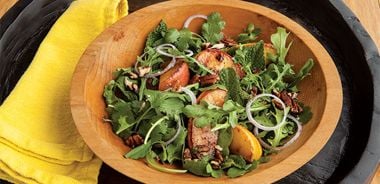Grilled Apple and Arugula Salad with Citrus Dressing and Toasted Pecans

Grilling veggies or fruit on a cedar plank emits a lovely smoked overtone and adds a mouth-watering appeal to this salad.
Orange Citrus Dressing
1/2 cup (125 mL) fresh orange juice
1 garlic clove, mashed and minced
Generous pinch of cloves
Salt and freshly ground black pepper
Finely grated zest from 1 lemon
3 Tbsp (45 mL) extra-virgin olive oil
Apple and Arugula Salad
Untreated cedar plank about 7 x 12 in (18 x 30 cm), soaked for a minimum of 1 hour
2 firm Honeycrisp apples, cored and cut into 8 wedges
1/4 red onion, very thinly sliced
4 cups (1 L) baby arugula, washed and spun dry
1/4 cup (60 mL) chopped cilantro
1/4 cup (60 mL) chopped mint leaves
1/4 cup (60 mL) chopped pecans, toasted
To make dressing, combine orange juice, garlic, seasonings, and zest in small deep bowl. Whisk vigorously to blend. Gradually whisk in olive oil until emulsified. Pour into 9 in (23 cm) shallow dish. Set aside.
Preheat barbecue. Rinse soaked plank and place on grill. Have a spray bottle with water handy in case wood flares up during grilling. Close lid and heat plank for about 4 minutes or until it begins to smoke and you can hear the wood beginning to crackle. Reduce barbecue heat to medium-low.
Place apple slices on plank along with red onion separated into rings and cook for about 10 minutes, or until apple slices begin to turn golden on the edges but are still relatively firm and onion rings soften. Remove from grill and place apple slices in dish containing citrus dressing. Turn slices in dressing to coat evenly, and refrigerate mixture until chilled, about 1 hour. Set onion rings aside to cool.
Combine arugula, cilantro, and mint in large bowl. Drain citrus dressing from apples over top and gently toss. Divide salad equally among 4 plates. Scatter with grilled apple slices, onion rings, and toasted pecans.
Serves 4.
Each serving contains: 202 calories; 2 g protein; 16 g total fat (2 g sat. fat, 0 g trans fat); 16 g total carbohydrates (11 g sugars, 3 g fibre); 12 mg sodium
source: "Vegan Barbecue Feast", alive #380, June 2014





